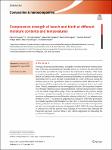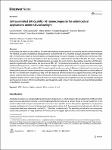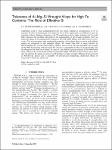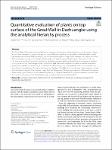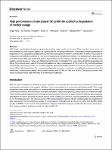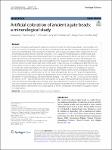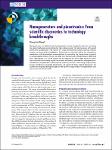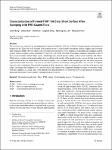Search
Author
- Osman, Ahmed I. (5)
- Daqing, Ma (3)
- Jorgensen, Ed (3)
- Li, Yan (3)
- next >
Subject
- kinh tế (26)
- Economics (12)
- programming (10)
- XRD (10)
- next >
Date issued
- 2020 - 2025 (2129)
- 2010 - 2019 (129)
- 2000 - 2009 (9)
- 1999 - 1999 (1)
Has File(s)
Search Results
Owing to increased environmental demands to replace petroleum-derived materials with more environmentally friendly materials, research has been directed towards the potential of using wood in the automotive industry. This study extensively investigates the compressive strength (fc) of two hardwood species (beech and birch) with different anatomical directions, at various moisture and temperature levels, in an attempt to understand the wood’s behaviour during the forming process. The experimental tests were performed at 20, 100 and 140 °C on specimens with five moisture levels, ranging from completely dry to wet conditions. Overall, irrespective of the investigated direction, the measured compressive strength exhibited a clear exponential trend with increasing moisture content over t... |
In this paper, we report on the synthesis of a new hybrid photocatalytic material activated by natural sunlight irradiation. The material consists of multiferroic nanoparticles of bismuth ferrite (BFO) modified through the growth of the Fe-based MIL-101 framework. Material characterization, conducted using various techniques (X-ray diffraction, transmission electron microscopy, FTIR, and X-ray photoelectron spectroscopies), confirmed the growth of the MIL-101 metal–organic framework on the BFO surface. The obtained system possesses the intrinsic photo-degradative properties of BFO nanoparticles significantly enhanced by the presence of MIL-101. |
Aluminum scrap is often contaminated with steel parts, leading to accumulation of Fe in recycled Al alloys. Consequently, low limits for Fe in Al wrought alloys are difficult to meet by recycling without dilution with primary Al. Wrought alloys with a higher tolerance for Fe could help overcome this problem and improve the sustainability of Al wrought products. Here we study the effects of increasing the Fe content in EN AW-6060, 6005A, and 6082 from 0.2 to 0.7 wt pct. The microstructure and mechanical properties of the alloys after extrusion and artificial ageing are compared to the standard alloys. We found that 6082 is more tolerant to above-standard Fe contents than 6005A, which in turn is more tolerant than 6060: the strength of the 6082-based alloy with increased Fe content is... |
The Great Wall of China was a military facility that has been continuously built and used for over thousands of years, and is a world-renowned cultural heritage site today. The plants growing on top surface of the Great Wall caused the damage of the Great Wall, but the process of removing these plants may further damage the body of the Great Wall. In this paper, based on the Analytic Hierarchy Process and the expert Delphi method, we selected 13 specific indices from three Constraint Layer factors, and then estimated and identified 45 species/categories of plants on top surface of the Dazhuangke section of the Great Wall. The results showthe constitution and the evaluation gradeof the evaluation system. The factor of Disruptive Effects plays the main guidance role in the evaluation ... |
In this paper, wideband, and ultrathin metamaterial absorber is proposed, analyzed and fabricated for Ku-band applications. The reported absorber has a nearly perfect absorptivity above 90% covering the entire Ku band (12–20 GHz) at normal incidence for both transverse electric and transverse magnetic polarization. This is due to the supported electric and magnetic resonances simultaneously. Consequently, the effective permittivity and permeability can be designed to obtain impedance matching with free space. This leads to the absorption of the entire incident energy in the metamaterial absorber. The suggested structure also shows a good absorption response (above 80%) under oblique incidence (from 0 to 50°). Therefore, the proposed absorber represents a good potential for Ku-band a... |
MOFs have considerable adsorption capacity due to their huge specific surface area. They have the characteristics of photocatalysts for their organic ligands can absorb photons and produce electrons. In this paper, the photodegradation properties of TiO2 composites loaded with UiO-66 were investigated for the first time for MO. A series of TiO2@UiO-66 composites with different contents of TiO2 were prepared by a solvothermal method. The photocatalytic degradation of methyl orange (MO) was performed using a high-pressure mercury lamp as the UV light source. The effects of TiO2 loading, catalyst dosage, pH value, and MO concentration were investigated. The results showed that the degradation of MO by TiO2@UiO-66 could reach 97.59% with the addition of only a small amount of TiO2 (5 wt... |
The resulting microstructure after the sintering process determines many materials properties of interest. In order to understand the microstructural evolution, simulations are often employed. One such simulation method is the phase-field method, which has garnered much interest in recent decades. However, the method lacks a complete model for sintering, as previous works could show unphysical effects and the inability to reach representative volume elements. Thus the present paper aims to close this gap by employing molecular dynamics and determining rules of motion which can be translated to a phase-field model. The key realization is that vacancy absorption induced motion of grains travels through a grain structure without resistance. |
The process of staining was frequently employed to enhance or alter the color of agate beads in ancient times. One of the key challenges in studying ancient beads is comprehending the intricate techniques employed to color agate stones. An understanding of the staining mechanism from a mineralogical standpoint offers insights into the level of technological advancement in different civilizations. In this study, the mineral structure of eight ancient agate beads from Xinjiang Uygur Autonomous Region, NW China, was analyzed using Micro X-ray fluorescence (µXRF), Raman spectroscopy, Scanning Electron Microscope (SEM), and Fourier Transform Infrared (FTIR) techniques. The color, transparency, mineral phase, and surface roughness of the beads were examined, revealing variations ranging f... |
Nanogenerators is a field that uses the piezoelectric and/or triboelectric effect for converting low-grade mechanical energy (termed as high-entropy energy) into electric power, with a great potential for applications in the Internet of Things, self-powered sensors, robotics, medical science, and even artificial intelligence. Piezotronics is a field that utilizes the piezoelectric polarization in third-generation semiconductors for controlling the charge-carrier transport in semiconductor devices. These two fields were first coined by Wang’s group in 2006 and 2007, respectively. This article reviews the background and initial ideas based on which we introduced the following original discoveries and effects: piezoelectric nanogenerators; triboelectric nanogenerators; self-powered sen... |
The wear tests are conducted on bending punches deposited with PVD CrN and AlTiCrN coatings using the newly proposed progressive die. Then, the surface quality of the formed product is characterized through the surface roughness measurement after forming of TRIP1180 steel sheets. The correlation between the tool wear, in terms of wear depth and roughness and the product surface roughness can be quantitatively analyzed. The results show that the roughness remains comparable to that of the as-received surface before failure occurs, which represents smooth product surface without severe scratches and defects. While micro scratches on the punch surface have no effect on the quality of the product surface, severe fretting wear on the punch surface leads to a deterioration in the surface ... |

